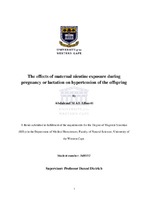| dc.description.abstract | Blood pressure and heart rate is known to increase during smoking. These effects are specifically associated with nicotine while the other components of tobacco smoke seem to be of minor importance. It is becoming increasingly clear that fetal nicotine exposure, through transfer of nicotine via the placenta, has numerous consequences that is detrimental to the health of the fetus and that these effects may last into adulthood or perhaps even manifest itself later in life. In this study, we investigated the effects of maternal nicotine exposure during pregnancy and lactation on the blood pressure of the male offspring. A preliminary study indicated that the female offspring do not become hypertensive. We were particularly interested to determine whether hypertension in the offspring could be prevented or attenuated by vitamin C (an antioxidant) therapy. When confirmed to be pregnant, female Wistar rats were divided into four groups. The control group (group 1) received saline (1ml/day, s.c), the animals in group 2 received nicotine (1mg/kg/day in ml, s.c), group 3 animals received a combination of saline (1 ml/day s.c.) and vitamin C (1g/l in drinking water) and the animals in group 4 received a combination of nicotine (1mg/kg/day, s.c) and vitamin C (1g/l in the drinking water) during pregnancy and lactation. At weaning eight animals from group 2 received vitamin C in the drinking water (1g/l) until the end of the experiment. Blood pressure and body weight were measured every two weeks for 5 months. Blood samples were collected, and serum prepared at 3 weeks and at 5 months for biochemical analysis. Total antioxidant capacity (TAC), thiobarbituric acid reactive substances (TBARS) and superoxide dismutase (SOD) assays were determined at 3 weeks; TAC was also measured at five months. After 5 months, the animals were sacrificed and abdominal aorta was excised for histological (H and E staining) and IHC (AGE) evaluation. From the data generated in this study, it was evident that maternal nicotine exposure during pregnancy and lactation increased blood pressure of male offspring but not female offspring. Exposure to nicotine during pregnancy and lactation significantly increased systolic blood pressure from 115±4.6 mm Hg in the first month to 147±6.1 mm Hg at five months (P<0.05), diastolic blood pressure was increased from 84±3.4 mm Hg in the first month to 110±7.2 mm Hg at 5 months (P<0.05) and MAP was increased from 94.8±3.8 mm Hg in the first month to 121±6.4 mm Hg at 5 months. Interestingly the MAP of the nicotine group was normal during the first two months. HR was similar in all groups at 5 weeks and 5 months. Maternal vitamin C supplementation in rats exposed to nicotine during pregnancy and lactation did not prevent development of hypertension of the offspring (MAP=121±6.4 mm Hg in the nicotine group vs 113.4±1.7 mmHg in the nicotine and vitamin C group, P>0.05). Supplementation with vitamin C in the drinking water after weaning significantly reduced blood pressure of the offspring (MAP=121±6.4 mm Hg vs 97.6±2.9 mm Hg respectively, P<0.05). No significant difference was found in any of the biochemical assays. Maternal nicotine exposure during pregnancy and lactation leads to alteration in aorta structure as evaluated by H and E staining. Structural alterations include protrusion of the intima and irregular arrangement of the vascular smooth muscle cells (VSMC) in the tunica media. Maternal vitamin C supplementation and vitamin C supplementation after weaning did not prevent the structural alteration of the aorta. Immunohistochemistry (IHC) indicated that the accumulation of AGE's in the nicotine group was stronger than in the control group. In conclusion, we show for the first time that hypertension induced by maternal nicotine exposure can be reversed after weaning by supplementation with vitamin C, an antioxidant. | en_US |

